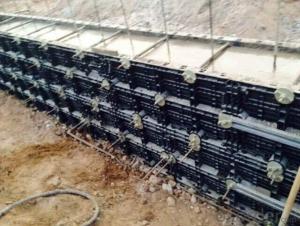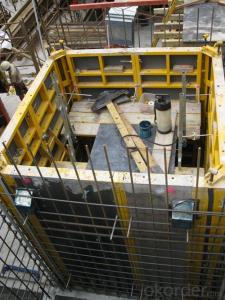Adjustable H20 Timber Beam Formwork
- Loading Port:
- China Main Port
- Payment Terms:
- TT OR LC
- Min Order Qty:
- -
- Supply Capability:
- -
OKorder Service Pledge
OKorder Financial Service
You Might Also Like
Detailed Product Description
Light weight Formwork
high bearing capacity Formwork
Rectangle Concrete Column Formwork
Square Concrete Column Formwork
H20 Timber Beam Formwork for Rectangle, Square Concrete Column Formwork
Description:
1. Structure sketch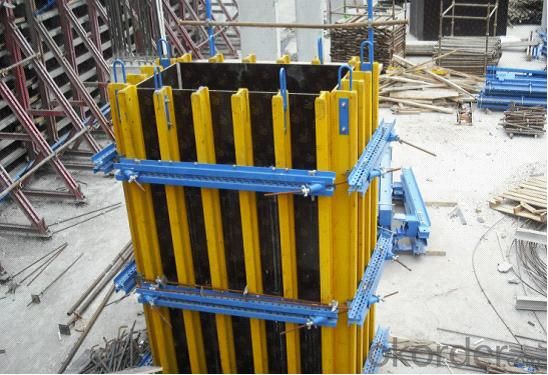
TBC system-A is a kind of formwork for pouring square or rectangle column, it is composed of four pieces of Tim-formwork, yoke, tie rod, wing nut, etc.
It will be designed according to column’s size; the formwork’s dimension is not adjustable.
Competitive Advantage:
1. Prefabricated connection, convenient and efficient.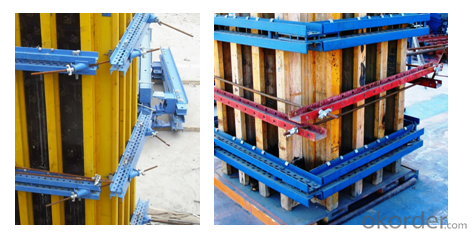
2. Light weight but high bearing capacity.
For conventional design, its load bearing capacity is 80KN/m2 with weight of 55-65kg/m2.
If required, the formwork can be specially designed for higher concrete pressures.
3. Timber is easy resized, so the Tim-formwork is relatively easier to change self’s size and shape. This approved formwork’s economical efficiency.
Applications:
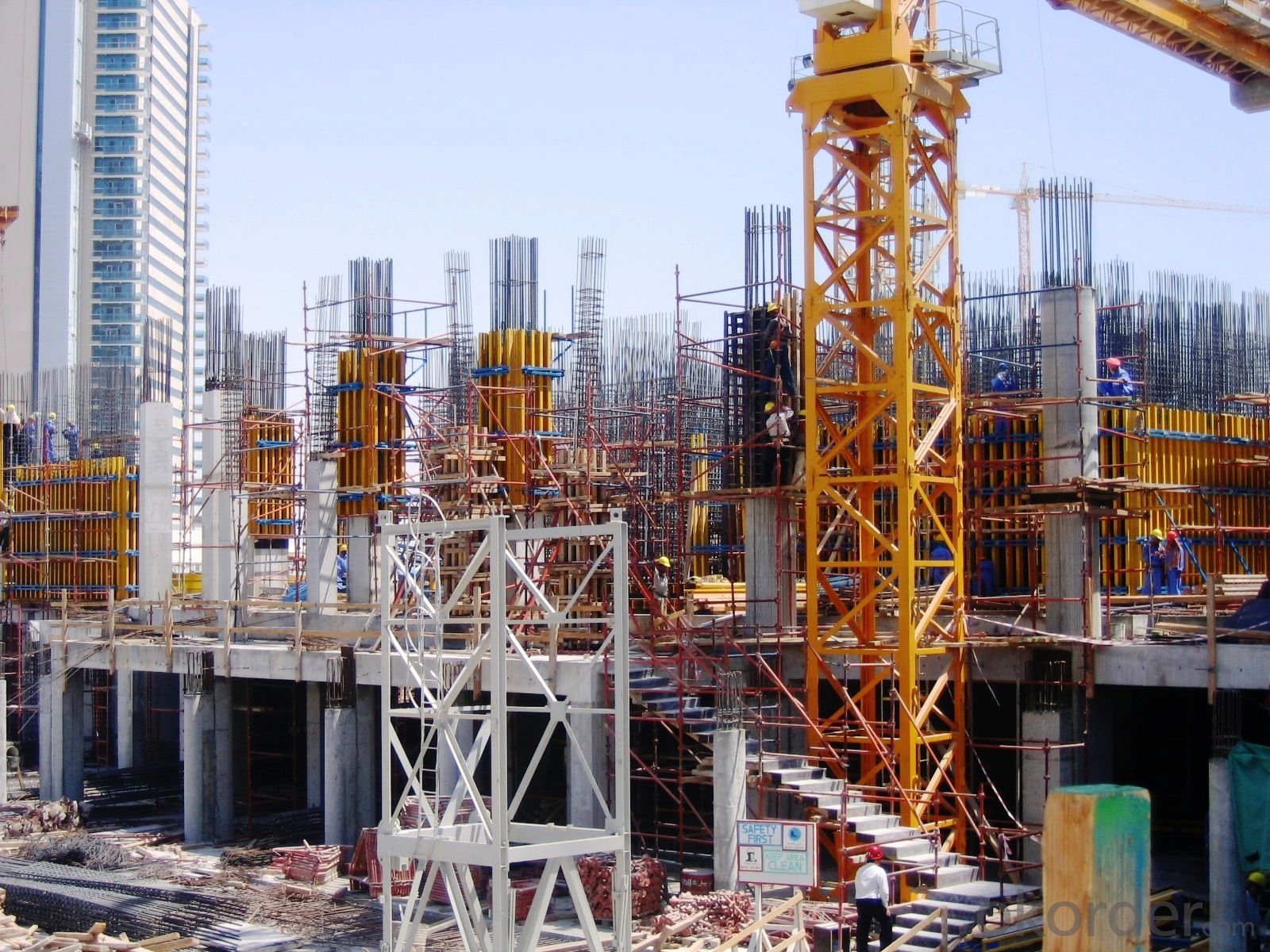

- Q:How does steel frame formwork handle different types of concrete pumping methods?
- Steel frame formwork is a versatile and robust system that can handle different types of concrete pumping methods with ease. Whether it is traditional concrete pumping or more advanced methods like shotcreting or self-compacting concrete, steel frame formwork provides a reliable and efficient solution. One of the key advantages of steel frame formwork is its ability to withstand the high pressure and force exerted during concrete pumping. The sturdy steel frames and panels are designed to support the weight of the concrete and the pressure created by the pumping process. This ensures that the formwork remains intact and does not deform or collapse under the extreme conditions. Furthermore, steel frame formwork is highly flexible and adjustable, allowing for easy customization to accommodate different concrete pumping methods. The panels can be easily moved and repositioned to create the desired shape and structure, ensuring a seamless flow of concrete during pumping. Additionally, the formwork can be easily adapted to suit different heights, angles, and curves, making it suitable for various concrete pumping techniques. In the case of shotcreting, where concrete is sprayed onto a surface at high velocity, steel frame formwork provides a stable and secure base for the process. The strong steel frames prevent any movement or displacement of the formwork, allowing for precise and accurate application of the shotcrete. This ensures a smooth and even finish, enhancing the overall quality and durability of the structure. Similarly, when using self-compacting concrete, steel frame formwork offers excellent support and containment. The formwork can be designed to have minimal gaps or joints, preventing any leakage or seepage of the self-compacting concrete. This ensures that the concrete maintains its desired flow and consistency, resulting in a high-quality finish. Overall, steel frame formwork is a reliable and adaptable system that can handle different types of concrete pumping methods effectively. Its strength, flexibility, and stability make it an ideal choice for construction projects where concrete pumping is involved.
- Q:Can steel frame formwork be used for both residential and commercial construction?
- Steel frame formwork is a valuable choice for both residential and commercial construction. This versatile and enduring solution is suitable for a range of construction projects, including residential and commercial buildings. It possesses remarkable strength and stability, enabling it to withstand the pressure and weight of concrete during pouring and curing. Moreover, steel frame formwork is both adjustable and reusable, offering a cost-effective option for small-scale residential projects and large-scale commercial developments alike. Its adaptability allows for the construction of diverse shapes and sizes, meeting the demands of various architectural designs. In summary, steel frame formwork is a dependable choice for both residential and commercial construction ventures.
- Q:Can steel frame formwork be used for residential buildings?
- Yes, steel frame formwork can be used for residential buildings. Steel formwork is commonly used in construction due to its durability, strength, and ability to withstand high pressure. It provides a stable and rigid structure, making it suitable for supporting concrete walls, slabs, and beams in residential buildings. Additionally, steel formwork can be easily assembled, disassembled, and reused, making it a cost-effective and efficient choice for residential construction projects.
- Q:How do you ensure the quality of steel frame formwork?
- To ensure the quality of steel frame formwork, several measures can be taken. Firstly, it is essential to source the steel from reputable suppliers who adhere to strict quality control standards. Conducting regular inspections of the steel frame formwork during and after the manufacturing process helps identify any defects or inconsistencies. Additionally, testing the steel frame formwork for strength, durability, and dimensional accuracy can be done using various non-destructive testing methods. Finally, following proper installation procedures and conducting periodic maintenance checks can help ensure the ongoing quality and performance of the steel frame formwork.
- Q:Can steel frame formwork be used for the construction of industrial structures?
- Indeed, the utilization of steel frame formwork is possible in the construction of industrial structures. With its versatility and durability, steel frame formwork proves to be an ideal system for erecting factories, warehouses, and power plants. Its ability to bear high loads and endure the immense pressures associated with such structures is exceptional. Moreover, the stability and precision it offers in molding concrete ensures that the industrial structure is built precisely as required. Its modular design facilitates effortless assembly and disassembly, rendering it a cost-effective option for large-scale construction endeavors. Overall, steel frame formwork emerges as a dependable and effective solution for industrial structure construction.
- Q:Are there any specific considerations for using steel frame formwork in cold climates?
- Yes, there are several specific considerations for using steel frame formwork in cold climates. 1. Material selection: In cold climates, it is important to use steel that is specially designed to withstand low temperatures. This ensures that the formwork remains structurally sound and does not become brittle or prone to cracking. 2. Insulation: Insulating the steel formwork is crucial to prevent heat loss and maintain a consistent temperature during the concrete curing process. This can be achieved by using insulating materials such as foam or thermal blankets around the formwork. 3. Condensation control: Cold climates often have high humidity levels, which can lead to condensation forming on the steel formwork. This can cause issues such as rusting and reduced structural integrity. It is important to implement measures to control condensation, such as using vapor barriers or incorporating proper ventilation. 4. Heating: In extremely cold climates, it may be necessary to provide additional heating to the formwork to ensure the concrete cures properly. This can be achieved through the use of heating systems such as electric or propane heaters, or by enclosing the formwork in heated enclosures. 5. Thermal expansion and contraction: Steel has a higher coefficient of thermal expansion compared to concrete. In cold climates, where temperatures can fluctuate significantly, it is essential to design the formwork system to accommodate the expansion and contraction of the steel. Failure to do so can lead to structural damage or misalignment of the formwork. 6. Surface protection: Steel formwork exposed to cold climates is more susceptible to corrosion due to the presence of moisture and de-icing salts. Adequate surface protection measures such as anti-corrosion coatings or galvanization should be applied to ensure the longevity and durability of the formwork. By taking these considerations into account, steel frame formwork can be effectively used in cold climates, ensuring the successful construction of concrete structures even in challenging weather conditions.
- Q:Can steel frame formwork be used for both monolithic and modular column construction?
- Both monolithic and modular column construction can make use of steel frame formwork. This system is known for its versatility and durability, as it can easily be adjusted to fit different construction methods. In the case of monolithic column construction, the steel frame formwork can be employed to create a temporary mold or framework that securely holds the concrete in place until it solidifies and hardens. This ensures the creation of seamless and continuous columns without any joints or gaps. By providing the necessary support and stability, the steel frame formwork guarantees that the concrete is poured and cured correctly. On the other hand, in modular column construction, the steel frame formwork can be utilized to produce individual formwork units that can be swiftly assembled and disassembled. These modular units enable the construction of columns with various sizes and shapes in an efficient and rapid manner. With the steel frame formwork's strength and rigidity, the concrete can be properly supported during the pouring and curing processes. To summarize, steel frame formwork is a versatile solution suitable for both monolithic and modular column construction. Its adaptability and durability make it an excellent choice for a wide range of construction projects.
- Q:Are there any specific considerations for using steel frame formwork in earthquake-prone areas?
- Yes, there are specific considerations for using steel frame formwork in earthquake-prone areas. Firstly, it is important to ensure that the steel frame formwork is designed and constructed to meet the seismic design requirements of the specific area. This includes considering factors such as the expected level of seismic activity, the soil conditions, and the building codes and regulations in place. Steel frame formwork should be designed to have sufficient strength and stiffness to withstand the seismic forces that may be exerted on it during an earthquake. This may involve using thicker steel sections, reinforcement, or additional bracing to enhance the structural integrity and stability of the formwork system. In earthquake-prone areas, it is also crucial to establish a secure connection between the steel frame formwork and the supporting structure. This can be achieved through proper anchorage and tie-down systems that are designed to resist the lateral forces generated by an earthquake. Adequate attention should be given to the detailing and installation of these connections to ensure their effectiveness. Additionally, it is recommended to use high-quality steel and ensure proper maintenance and inspection of the steel frame formwork. Steel with a high tensile strength and good ductility can provide better resistance to the dynamic forces experienced during an earthquake. Regular inspection and maintenance can help identify any potential issues or damage, allowing for timely repairs or replacements to maintain the formwork's integrity. Finally, it is crucial to consider the safety of workers during the construction process in earthquake-prone areas. This may involve implementing additional safety measures such as providing proper training on earthquake response and evacuation procedures, ensuring the availability of safe zones during seismic events, and using protective equipment to minimize the risk of injuries. Overall, using steel frame formwork in earthquake-prone areas requires careful consideration of design, construction, connection, material quality, maintenance, and worker safety. It is essential to consult with experienced engineers and adhere to local building codes and regulations to ensure the safety and stability of the construction in such areas.
- Q:What are the different types of scaffolding systems used with steel frame formwork?
- There are several types of scaffolding systems that are commonly used with steel frame formwork, including frame scaffolding, tube and clamp scaffolding, and system scaffolding. Frame scaffolding consists of vertical frames and horizontal cross braces that are interconnected to create a stable structure. Tube and clamp scaffolding uses tubes and clamps to connect various components and create a versatile scaffolding system. System scaffolding, also known as modular scaffolding, utilizes pre-engineered components that can be easily assembled and adjusted to meet specific project requirements. These different types of scaffolding systems offer flexibility, durability, and safety when working with steel frame formwork.
- Q:What is the average time required for assembling and disassembling steel frame formwork?
- The average time required for assembling and disassembling steel frame formwork can vary depending on the size and complexity of the structure. However, in general, it can take anywhere from a few hours to a few days for experienced workers to complete the process.
1. Manufacturer Overview |
|
|---|---|
| Location | |
| Year Established | |
| Annual Output Value | |
| Main Markets | |
| Company Certifications | |
2. Manufacturer Certificates |
|
|---|---|
| a) Certification Name | |
| Range | |
| Reference | |
| Validity Period | |
3. Manufacturer Capability |
|
|---|---|
| a)Trade Capacity | |
| Nearest Port | |
| Export Percentage | |
| No.of Employees in Trade Department | |
| Language Spoken: | |
| b)Factory Information | |
| Factory Size: | |
| No. of Production Lines | |
| Contract Manufacturing | |
| Product Price Range | |
Send your message to us
Adjustable H20 Timber Beam Formwork
- Loading Port:
- China Main Port
- Payment Terms:
- TT OR LC
- Min Order Qty:
- -
- Supply Capability:
- -
OKorder Service Pledge
OKorder Financial Service
Similar products
New products
Hot products
Hot Searches
Related keywords

















